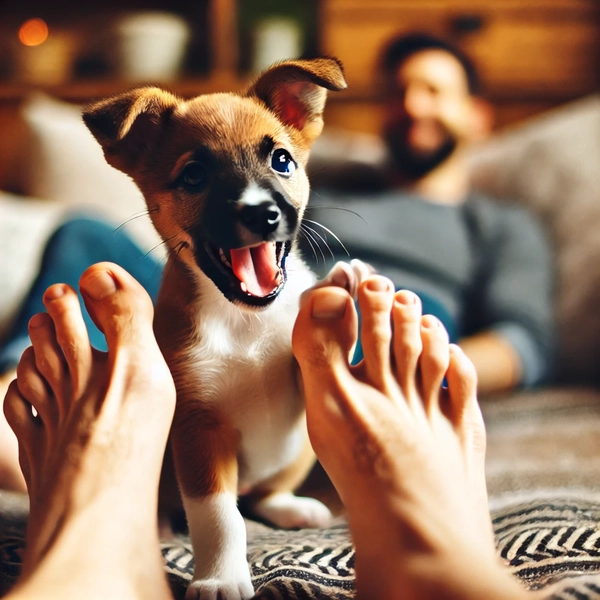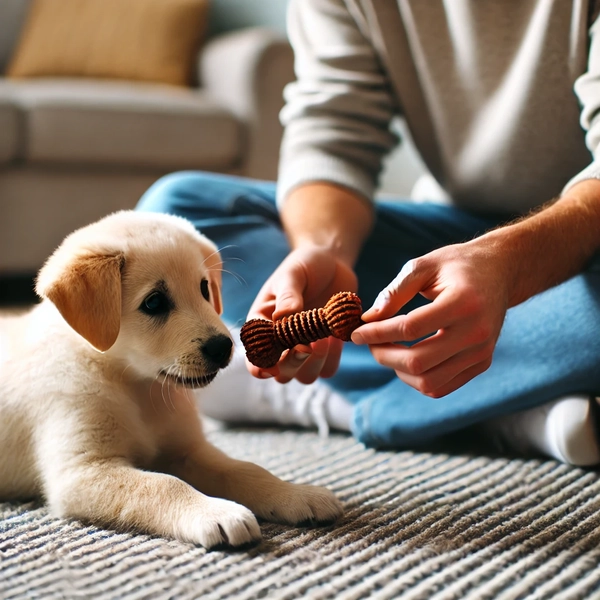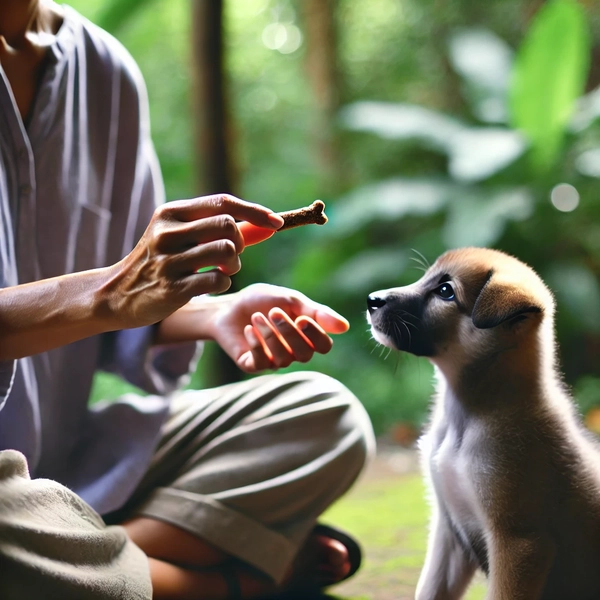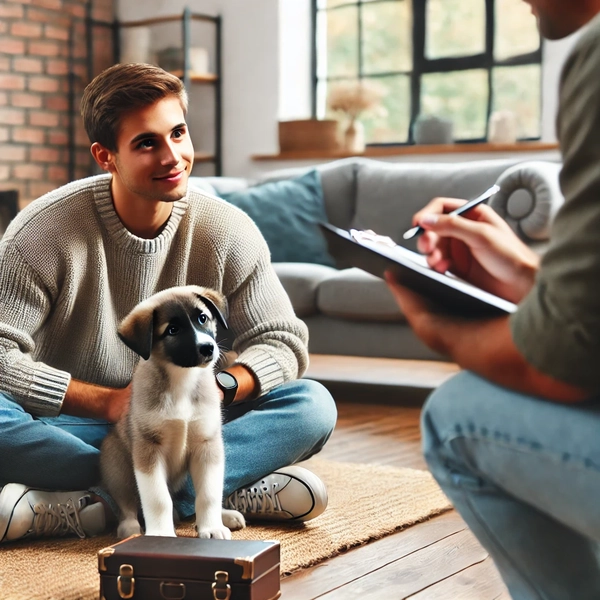How to stop a puppy from biting your feet and hands: If you’re thinking about getting a puppy, you may want to refrain from letting him/her see your hands and feet.
Puppies are extremely full of laughter, energy, and curiosity. They tend to put everything in their mouths, including fingers and toes, that serve as their temporary chew toys!
This is adorable initially, but it can be rather excruciating and irritating. Teaching a puppy not to nip at one’s hands or feet is one of the most crucial aspects, considering nipping or biting comes naturally to all puppies. But feel at ease! There are some easy, practical techniques to teach your puppy good behaviors.
This article will discuss the onset of puppy-biting behavioral issues, including preventive measures and strategies to ease the training process.
Why do puppies bite?

Biting is a typical behavioral pattern for dogs, but their caretakers can always attempt to correct its manifestations. Puppies don’t reward each other by biting, nor being destructive is the purpose of it. Here are some of the common causes of the typical puppy biting behavior.
- Teething: Like a human baby, a puppy has to go without teeth for a little while. The soft tissues of the mouth tend to be very painful, and chewing on random objects makes the issue much better.
- Playing: Chewing at things is a natural action for puppies when engaging in fun activities. When they are part of a litter, they chew one another for enjoyment and bonding purposes.
- Exploring: A pup is a baby dog nourished to chew on things (even people).
- Over-excitement: Puppies tend to get too hyper for their good, so they use their teeth.
Knowing the reasons that cause your puppy’s unwanted behaviors can help you take appropriate action. You could find this behavior challenging to control in your puppy. Let’s look into this more carefully.
How to Stop a Puppy From Biting Your Feet and Hands

1. Teach them about mouthing
Forgiveness for the damage done or for an injury caused to the individual by the dog is known as bite inhibition.
Pups in a pack gain this skill from their litter mates and their mother. When one of the pups bites too hard, yelps from the other pups can be heard, and the fighting will stop. In time, the offending puppy learns to avoid excessive, painful bites.
You can also do this at your house:
- Yelp when bitten: Whenever your puppy gnaws at you, let out a squeal-like sound soft enough that a puppy can easily imitate it. This replicates the cry of another pup being nibbled on.
- Stop playing: Upon yelping, withdraw strenuously from your puppy for a few seconds. This helps them understand that aggressive play means cessation of the activities.
- Resume gently: Shortly, continue the play. In case your puppy nips again, yelp and stop as before. This is to help them comprehend that easy play carries on, but it is only hard biting that stops.
Pro Tip: Be firm! Pet owners are asked to remember that puppies operate better with schedules. To teach them, give the same reaction every time there is a bite.
2. Use ‘energy diverting’ devices
Puppies have lots of energy, and sometimes, their teeth come out because they are excited. The idea is to stop the biting by changing their target.
- Provide an item to chew on: The puppy’s chewing behavior can be redirected by giving it a chew toy when it begins to bite the owner. This provides the puppy with an object to bite that is not the owner’s skin and allows the owner’s hands to be safe.
- Provide them with some toys they can use in motion: A tug-of-war rope or balls for fetch can keep the puppy’s moth busy without the owner’s skin being involved.
This is effective because puppies are very easy to distract. It is a matter of giving them something to work on in place of them biting your feet and hands.
3. Implement Time-Outs
When all efforts to redirect your puppy’s biting have failed, you can consider adopting a time-out for them.
- Let them cool off: Biting is a non-constructive action from your puppy, and doing so endlessly can lead you to want to remove them from interactive play.
- Take the dog to a place free of noises for a minute or two: The place could be another section of the house or a crate if one is available and the dog is accustomed to it.
- Maintain control: Timeouts should be devoid of punishment connotations. They are simply a form of reprieve from the puppy’s excitement to allow a re-set of the behavior.
- Necessary: Because puppies have short attention spans, timeouts should be brief and effective enough to interrupt the behavior.
4. Training Basic Commands
Teaching your puppy basic commands such as sit, stay, or leave can help you control its behavior. For instance, you can issue a ‘sit’ command mid-bite, which stops the puppy from biting.
- Teach “leave it”: This is an excellent command to prevent something from happening. Just before your puppy tries to bite something, give the command “leave it” and offer him or her a toy or treat.
- Remember to praise good actions: Positive reinforcement is very effective. For instance, after the puppy listens to you and stops biting, give him a treat or stroke him.
- Repetition is essential: Command them daily when the puppy is not biting. Obviously, the more they do it, the more proficient they will become at obeying.
What Not to Do

It is equally important to teach your puppy to stop biting as it is to ignore certain behaviors that can escalate the problem.
1. Don’t Punish
In Some instances, punishing a puppy for biting can cause more of a problem than resolving it. This is where a puppy might get confused about the reason for the punishment. It is better to encourage your puppy with positive reinforcement. Reinforce good behavior, ignoring the bad ones.
2. No Roughhousing
As tempting as it is to want to rough play with a puppy twice their age, it becomes more challenging to manage the biting. Better still, only engage in non-contact play where the hands are not the primary source of play.
3. Don’t Pull Away Suddenly
Puppy biting will sometimes provoke a response where someone yanks their hand or foot back. This only encourages the pup to bite harder or chase after the hand because it has become a game. Instead, do not move or go ‘ouch’ to let the puppy know it is crying.
Advice for preventing Puppy Biting
Puppy biting is understandable. However, correction of such behavior involves time, effort, and tact. The following are some valuable tips that will facilitate the process:
| Tip | Explanation |
| Stay Calm | Puppies respond to your energy. If you get frustrated, they’ll feel it too. Stay calm and positive. |
| Provide Plenty of Toys | Give your puppy a variety of chew toys to help with teething and keep their mouth busy. |
| Don’t Encourage Rough Play | Avoid games that encourage biting, like rough wrestling. Play games like fetch or tug-of-war instead. |
| Socialize with Other Puppies | Puppy classes or playdates can teach your puppy how to interact properly with others. |
| Be Patient | Training takes time. Don’t expect results overnight, but keep up the good work, and you’ll see progress! |
When to Ask Help from Experts

Puppies generally stop nipping at biting controls when they are older. Nonetheless, if there is a problem after excessive or aggressive biting, consult a dog trainer or a veterinarian. They will provide the necessary help and training methods to suit your puppy.
Your concern may require some additional assistance in the following cases.
- There is no play in your puppy’s biting—quite the opposite.
- You have more than one issue but have never had any success.
- Your puppy’s biting encroaches on the safety and peace within the home.
Prioritize: Every puppy is unique. Some learn not to bite faster, while others take longer.
Stopping your puppy from biting hands and feet as chew toys can be time-consuming, but with focus and consistency, it can be achieved. Be sure to praise him, provide him with enough play items, and refrain from engaging in violent sports. Using simple commands and taking a break can make a huge difference.
Most importantly, one should always keep her calm and understand that the pup is still a work in progress. With love, patience, and the right approach, the puppy will mature into a well-mannered and affectionate pet.
Good luck with your training journey, and have fun cherishing every moment with your puppy!